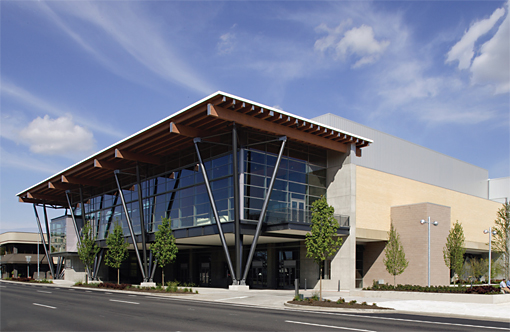| 제목 | [DAIKIN] OFFICE BUILDING - Salem Conference Center | 작성일 | 16-06-16 11:08 |
| 글쓴이 | 최고관리자 | 조회수 | 5,465 |
본문
Evoking the natural beauty of the Willamette Valley, the Salem Conference Center is more than an eye-catching renovation in downtown Salem, Oregon.
CASE STUDY
Convention Center
Name
Salem Conference Center
Location
Salem, OR USA
Facility Size
29,000 ft2 facility
Issue
HVAC for a properly designed sustainable building that reduces life cycle costs
Solution
(2) 150-ton Daikin Magnitude® chillers and (23) Daikin Vision® indoor air handlers
Daikin Chillers and Air Handlers Cut Noise and Energy Costs at the Salem Conference Center
With its 29,000 square feet of convention, theatre, banquet, trade show and classroom space evoking the natural beauty of the Willamette Valley, the Salem Conference Center is more than an eye-catching renovation in downtown Salem, Oregon. It's an example of how sustainable design not only represents a region's natural beauty, but can also contribute to the area's economic impact. Energy-efficient features such as deep roof overhangs and window sun control minimize solar heat gain. Magnitude chillers from Daikin help to achieve exceptional energy efficiencies and minimize operating sound levels so patrons aren't disturbed by noise and vibration from the mechanical room. And as the new anchor for the southern end of downtown, the Salem Conference Center has already seen an operating profit since its opening in March 2005.
"The project had been discussed and deliberated for 20 years," said Dan Riordan, revitalization supervisor, City of Salem. "There was no previous conference center in Salem—the site was a former Ramada Inn on the southern edge of downtown, which had little to offer in the way of economic growth. Most of the economic gain was coming from the retail district on the north end of downtown. It wasn't until we looked at the broader economic impact of the Conference Center that the project became viable."
The result of the focus on improving the economic impact was evident within the first 10 months of operation.
The Conference Center hosted 284 events attended by some 45,000 people and also provided classroom and meeting space for nearby Willamette University. This kind of activity helped the Center realize a small profit even within the first year. "And typically, conference centers do not make money in the first year," said Riordan.
Once the goal of improving the economics of the southern edge of downtown was in place, it was natural for the city to consider the environmental impact as well. "Designing a sustainable building was a given, not only because of the region's appreciation for the natural environment, but also because we recognize that sustainable buildings reduce life cycle costs if they're designed properly," said Riordan.
Sustainable design features range from recycled flooring to efficient cooling system
From the first drawings, the building was designed for LEED® certification. For example, LEED awards points for re-use of existing materials, and 75 percent of construction waste was recycled or salvaged. The old Ramada Inn is literally underfoot—it was crushed up, combined with concrete and used to make the terrazzo floors. Other sustainable design features include reflective roofing and underground parking, which minimize heat islands. The floor-to-ceiling windows are programmable to open and close automatically to regulate natural ventilation and air circulation. The building is currently LEED registered, with certification pending.
When summer temperatures require air conditioning, two Daikin 150-ton Magnitude chillers and 23 Daikin Vision® indoor air handlers condition and circulate the air. The equipment was chosen because it met project requirements for efficient operation and low sound levels. An energy cost analysis estimated that the HVAC system would provide 20 percent better efficiency than comparable equipment.
"A properly-designed chilled water system can provide very good energy efficiency," said Ray Quisenberry, senior mechanical designer with Interface Engineering, Salem, who specified the project. "This project was of a size that provided for a decent payback period for the extra up front first cost of a chiller system. The low operating cost of these particular chillers made the payback even better."
Added Quisenberry, "Noise control was also very high on the list of the owner's concerns, and noise and vibration from a central chiller plant is easier to design for and control than a more dispersed system such as rooftop package equipment or split systems." Sound pressure ratings for the Daikin chiller are 77 dBA per ARI Standard 575, among the lowest in the industry

Daikin Magnitude chillers help to achieve exceptional energy efficiencies and minimize operating sound levels.
Nickel test demonstrates low vibration and noise
Introduced in 2004, the Daikin Magnitude chiller is not only quiet and energy-efficient, it's designed for long-term operation. It uses R-134a refrigerant, which has no phase-out schedule or ozone depletion potential. LEED recognizes this environmental feature and awards one point for systems that do not use HCFC refrigerants.
The key to the chiller's efficiency and quiet operation is the compressor's digitally-controlled magnetic bearing system, which replaces conventional lubricated bearings. The compressor rotor and impeller shaft "float" on a magnetic cushion, which virtually eliminates vibration. To further reduce operating sound levels, the compressor's magnetic bearings eliminate the metal-to-metal contact noise of conventional bearings.
"While energy efficiency was a primary factor in choosing a Magnitude chiller, operating sound levels were equally as important," said Joel Rohrs, senior project manager, Rushforth Construction, Tacoma, Washington. "The mechanical room is located on the third floor of the facility, and we wanted to mitigate noise and vibration as much as possible so visitors can easily hear lectures and presentations without background noise interruptions.
"We bench-tested both chillers at Daikin's manufacturing facility for sound and efficiency," said Rohrs. "One test demonstrated how smoothly and quietly the chiller runs. We set a nickel on its edge on top of the chiller while it was running at 80 percent of capacity. We were amazed that the nickel didn't move. Vibration and its associated noise are a huge drawback of conventional chillers. This test demonstrated that the Magnitude chiller has none of those issues."
The air handlers, too, are designed for quiet operation, and no additional sound attenuation was added to the equipment. To further reduce sound levels, double-walled duct and duct lining was installed where necessary.
Part load efficiency pays off
In addition to its vibration-free operation, the chiller consumes far less power—and costs less to operate—than conventional chillers. The Conference Center is not always occupied, so a chiller that could efficiently run at part load was critical. Because of its integral variable speed drives, the Daikin chiller can operate down to 10 percent of its load with extraordinary efficiency. Energy savings with part load performance are as low as .375 kW per ton IPLV. By comparison, a constant speed chiller would be forced to cycle on and off below approximately 25 percent load, resulting in less temperature control and more wear and tear on the compressor motors.
"The energy and cost savings is incredible," said Todd Stiers, Conference Center facility manager. "Other comparable chillers require 1,000 amps per leg at start-up. By contrast, when the Daikin chiller starts up, each compressor takes only seven to 10 amps. Also, it ramps up more slowly, so we don't require a big surge of electricity in the beginning, which would be quite costly."
To further increase efficiencies, an underfloor, closed-loop hydronic system provides radiant heating and cooling. Underfloor pipes circulate cool or warm water as needed. When air conditioning is required, the Vision air handlers, which are equipped with variable frequency drives, supply cool and fresh air to every space of the Conference Center. Also, a large energy recovery unit transfers energy from building relief air to pre-condition fresh air entering the Conference Center.
Well worth the wait
Even though the residents of Salem waited a long time for their conference center, today they are enjoying the best of what sustainable design offers—not only a beautiful building that exemplifies the Pacific Northwest, but also one that showcases the best of energy efficiency and positive economic impact.

Daikin Vision air handlers, which are equipped with variable frequency drives, supply cool and fresh air to every space of the Conference Center.
| 이전글 | [DAIKIN] OFFICE BUILDING - One World Trade Center 2016-06-16 | ||
| 다음글 | [DAIKIN] OFFICE BUILDING -Thanksgiving Tower 2016-06-16 | ||






